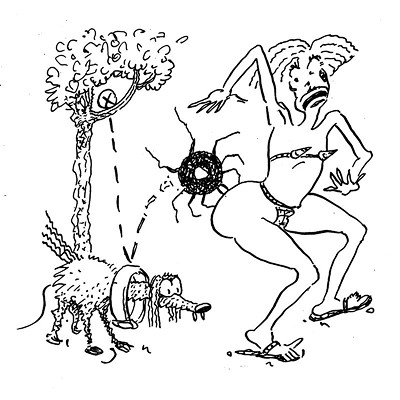Dear Cecil: I'm contemplating dog pimping — selling my rare-breed male dog's procreative capability to owners of his female counterparts. Is there such a thing as doggy venereal disease?
— Warren
Warren, dogs can contract a variety of diseases while getting it on. These range from run-of-the-puppy-mill (e.g., genital herpes) to the exotic — the parasitic infection leishmaniasis, endemic elsewhere but seen only occasionally in the U.S., can apparently spread via dog intimacy. Of major concern is canine brucellosis, a nasty bacterial infection of the reproductive tract that can lead to inflammation and infertility in males and aborted litters. Purebreds are often tested for brucellosis before mating (it seems to be especially common among beagles); it's rarely fatal, but infected dogs are sometimes euthanized to prevent its insidious spread.
The really sexy dog STD, though, is something called canine transmissible venereal tumor, a very rare example of what’s known as a parasitic cancer. Unlike most other contagious cancers such as cervical cancer in humans, CTVT isn’t spread by a virus but (as recently proved) by cancerous cells themselves. Genetic analysis suggests the tumor originated in an individual wolf or domesticated dog, probably in east Asia, 200-2,500 years ago. This long-dead canid’s much-mutated cells are still alive and being passed along during coitus centuries later, making it the longest-lived mammalian cell line known. The disease is now found throughout the world, especially where there are large populations of strays. It can be treated with surgery, radiation, and chemo, but most otherwise healthy dogs recover spontaneously after several months.
Luckily for us, there are no known parasitic cancers in humans, and only two additional ones affect animals. One arose spontaneously in a laboratory hamster around 1960: it’s a reticulum-cell sarcoma that can be spread by casual contact, cannibalism (hamsters’ souls are a lot darker than you might think), and mosquito bites; the tumor grows in the larynx and eventually leads to suffocation. The other is a condition threatening Tasmanian devils with extinction in the wild, called devil facial-tumor disease. It’s spread by bites; the tumors grow around the mouth and eventually cause death by starvation.
More good news: you can safely breed your dog without fear of his contracting syphilis or gonorrhea — those are pretty much limited to humans. And unless he’s very well trained, you probably don’t have to worry about him picking anything up from a toilet seat.
Why don’t raindrops pummel us into chopped liver? Thousands plummet out of the sky at terminal velocity yet they splatter off of us harmlessly. A skydiver told me it really hurts to fall through them, but aren’t they moving at the same speed? He said it’s because he’s falling on the pointy end. He was kidding, right?
— Cranistopolous Bobbaganoosh
A person who believes it’s a good idea to jump out of a plane might believe any damn thing. I do know he’s wrong, though. Raindrops don’t have pointy ends, despite what you see in weather maps and kindergarten art. Small drops are spherical, larger ones are flattened on the bottom, and the largest are hollowed out like parachutes. (I almost hate to give your friend the satisfaction, but I’m forced to admit there’s one type of precipitation that can in fact be pointy on top. Graupel, or soft hail — it’s made of snow and frozen water droplets cemented together — sometimes forms in a conical shape and falls apex upward.)
Terminal velocity doesn’t always equal high velocity. For any given falling body, terminal velocity is the speed where the accelerating effect of gravity’s pull and the slowing effect of air resistance balance out — it’s the point at which the body simply can’t fall any faster. Little things like raindrops have low weight relative to their cross sections, hence lots of drag, hence low terminal velocity. For drizzle, terminal speed is less than five miles per hour. For the largest and fastest raindrops it’s still only about 20 miles per hour.
A skydiver, having a greater ratio of weight to cross section than a raindrop, has a much higher terminal velocity — say, 130 mph. At that speed (ignoring the effects of disturbed airflow around your body), you’re catching up to falling raindrops at at least 110 mph, which pointy or not has got to sting a bit.
By cecil adams
Comments, questions? Take it up with Cecil on the Straight Dope Message Board, straightdope.com, or write him at the Chicago Reader, 11 E. Illinois, Chicago 60611. Cecil's most recent compendium, Triumph of the Straight Dope, is available at bookstores everywhere.























